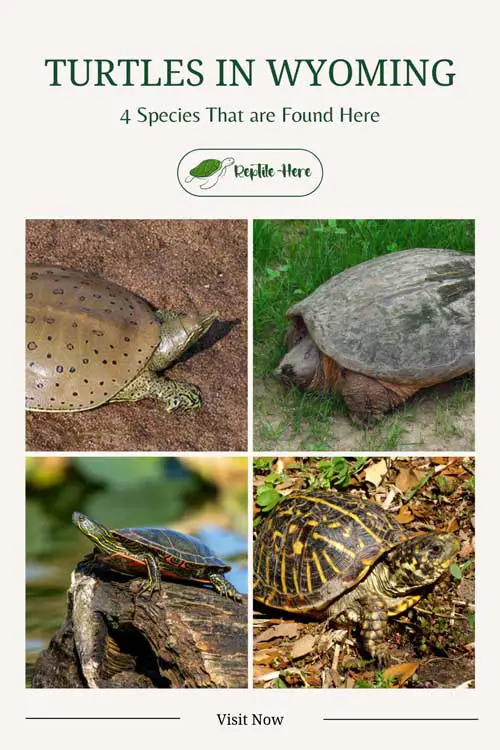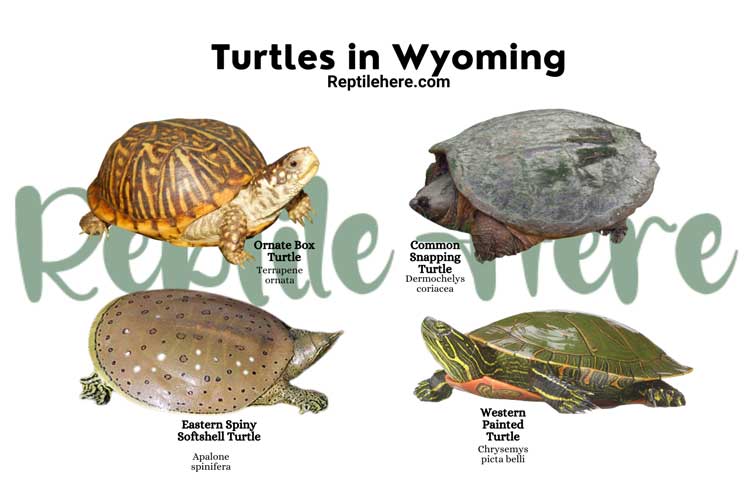Turtles in Wyoming – 4 Species That are Found Here
Wyoming is home to 4 native turtle species namely the common snapping turtle, eastern spiny softshell turtle, western painted turtle, and the ornate box turtle. The first three are aquatic while the 4th one is the only land turtle.
In this guide, we’ll take a look at these species and what physical traits they bear, where they live in Wyoming, what they eat, their shell size, lifespan, conservation status, and more.
4 Types Of Turtles In Wyoming
Contents
1. Common Snapping Turtle

- Scientific name: Chelydra serpentina
- Common name: Snapping Turtle
- Family: Chelydridae
- Size: 8 to 18 1/2 inches
- Lifespan: 30 to 50 years or more
- Conservation status: Least Concern
Common snapping turtles are widespread throughout Wyoming in waterbodies that are larger and permanent. An average adult is pretty large and has a shell length of 18½ inches long.
This species has a chunky head, a long tail, and large webbed feet. The shell color is black or olive and has no distinct pattern.
These Wyoming snapping turtles are known for their powerful jaws—they’re so strong that these turtles eat other turtles!
You’ll find them in waterbodies with muddy bottoms. Examples include marshes, ponds, lakes, rivers, and even shallow streams. They generally prefer waters with aquatic vegetation in plenty and foods such as fish, frogs, birds, etc.
These Wyoming turtles generally show docile behavior but can get quite aggressive if taken out of water. The best way to calm it is to take it back to the waters, where it feels safe.
2. Eastern Spiny Softshell Turtle
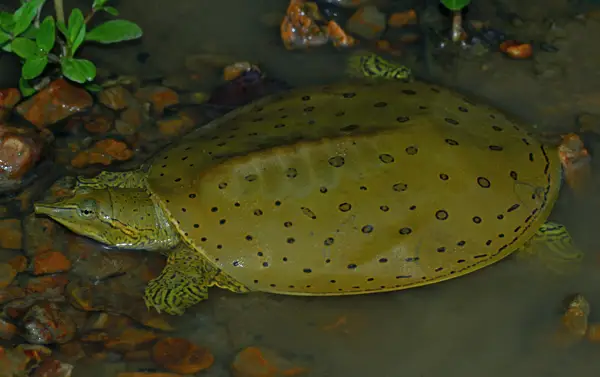
- Scientific name: Apalone spinifera
- Common name: Spiny Softshell Turtle
- Family: Trionychidae
- Size: 5 to 9 inches (males), 12 to 20 inches (females)
- Lifespan: 30 to 70 years
- Conservation status: Least Concern
The Eastern Spiny softshell turtle is a medium-to-large freshwater species that live in Wyoming’s lakes, streams, and rivers with muddy or sandy bottoms and little or no vegetation.
Female spiny softshell turtles are usually larger than males. And unlike other turtles, this species has a flexible, leather-like carapace that’s extremely rounded and flattened. The shell color can be olive grey or yellow-brown. Just like other softshell turtles, this species also has a snorkel-like snout.
The young ones feature well-defined round spots that are easily visible on the shell (though these spots become invisible as they transition to adulthood).
Spiny softshell turtles in Wyoming tend to eat anything they find in the waters including crayfish, insects, small fish, and so on. They hunt by burying themselves in the mud or sand while keeping their head uncovered to grab food as it swims by.
These turtles are also able to breathe underwater by taking in oxygen through their throat skin. This is a useful adaptation given that they don’t spend a lot of time out of water.
Other adaptations of these turtles include webbed feed, long claws, and extremely flat shells that enable them to quickly swim away from predators and burry in the muddy bottom of the waters they reside in.
Also read: Turtles in Massachusetts
3. Western Painted Turtle
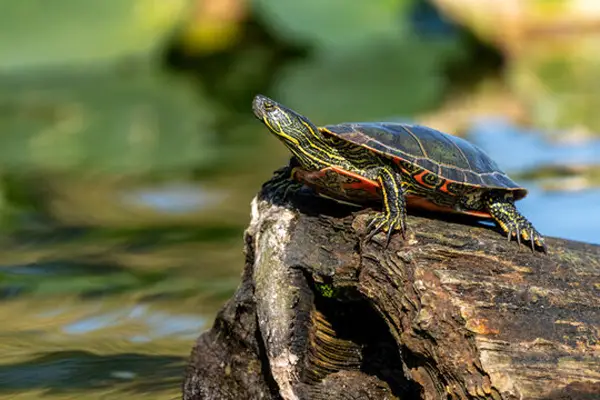
- Scientific name: Chrysemys picta belli
- Common name: Westland Painted Turtle
- Family: Emydidae
- Size: 4 to 10 inches
- Lifespan: 30 to 40 years
- Conservation status: Least Concern
The Western painted turtle is a subspecies of painted turtle and is also found in Wyoming waterbodies.
This turtle is identified by an oval-shaped carapace that lacks a ridge in the middle. The carapace is usually dark olive or black in color.
The lower side of the shell is usually red, with multiple dark markings in the center. And the skin itself is covered with yellow stripes.
Westland painted turtles of Wyoming are aquatic and their webbed feet help propel them in the waters.
The most common habitats for this turtle in Wyoming include slow-moving rivers, shallow streams, and lakes. They choose these areas because they can easily find food.
Given that they’re omnivorous, they feed on aquatic vegetation as well as meat from insects, snails, shrimps, tadpoles, and earthworms.
Their hatchlings are more carnivorous to help take in more proteins for building muscle.
4. Ornate Box Turtle
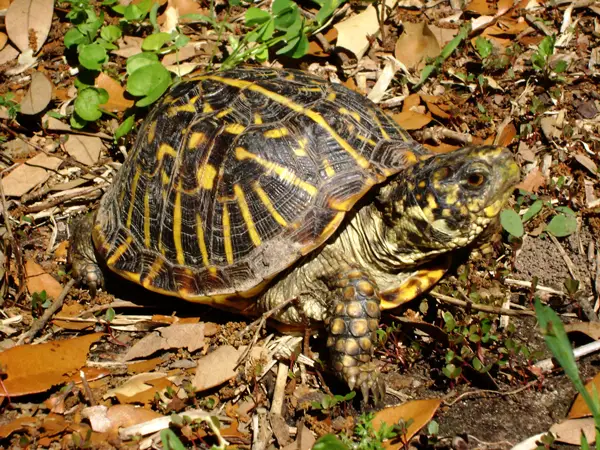
- Scientific name: Terrapene ornata
- Common name: Ornate Box Turtle
- Family: Emydidae
- Size: 5 to 7 inches
- Lifespan: 40 to 60 years
- Conservation status: Near Threatened
Ornate box turtles are present in Wyoming and are recognized by the beautiful pattern on their carapace. This eye-pleasing pattern is sometimes referred to as a starburst pattern.
Their skin is grey and may feature yellow or white spots. Male heads occasionally feature green color.
Though there exists a little distinction between the males and females of these Wyoming box turtles, males are generally smaller than females.
During hot weather, this turtle requires water to help regulate its body temperature.
The Wyoming species of turtle are known to hibernate in burrows during cold weather. They’re also capable of surviving in frozen soils for several days.
Being omnivorous in nature, and opportunistic feeders, these turtles will gladly feed anything available to them in their habitat or what’s abundant in a given season.
They have been observed eating fruits, vegetables, grasshoppers, and various other insects.
Also, keep in mind that these box turtles are pretty shy and don’t like being handled excessively. As such, you may want to avoid approaching them suddenly while in the wild in Wyoming.
Related: Turtles in North Carolina
Conclusion
These are the 4 turtle species native to Wyoming state. The list comprises 3 aquatic species; the common snapping turtle, western painted turtle, and eastern spiny softshell turtle. The state has only one terrestrial species, the ornate box turtle.
This guide has also discussed the key facts about each of these 4 species like physical appearance, diet, habitat, average adult size, and so on, to help you better understand their behavior and unique traits that set them apart from each other.
